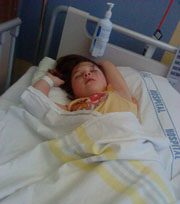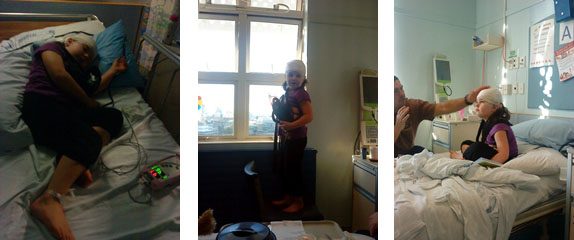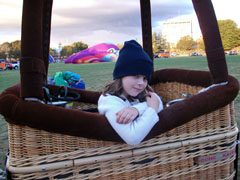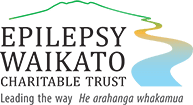Ysabella (Bella) was born in 2005. At three weeks of age she started screaming non-stop and was refusing to feed and we were told by the doctors that she had ‘reflux’ and ‘colic’. Bella was given a PH probe at about 14 months of age, and then a gastric scope (which is when a camera is put into the tummy and samples are taken) when she was about three years old. This scope was to determine why Bella continued to scream incessantly. We never heard back from the hospital with the results until much later.

One night, through sheer exhaustion, my husband and I let Bella sleep on the couch, whilst we relaxed, and we witnessed Bella’s first seizure. She may have been having seizures all along but we had never seen them until then.
We phoned the Waikato hospital and the staff there organised a video EEG for the seizures and they also had results from the previous gastric scope which they had forgotten to give us. Bella was diagnosed with Eosinophilic esophagitis, an autoimmune disorder, which is an allergic inflammatory condition of the oesophagus that involves eosinophils, a type of white blood cell.
Bella’s first EEG was done up at the Waikato Hospital when she was 3 years and 8 months old, and the EEG showed bi-lateral epileptic activity, confirming that she had tonic clonic epilepsy.
All of Bella’s seizures happen at night and they start 1 to 2 hours after going to bed. They are generalized tonic-clonic seizures with jerking of all limbs. Frequently her eyes will roll back, and she will grunt as if struggling to breathe. If woken she will be confused and very distressed for a number of hours. However, if left asleep, Bella remains asleep for the remainder of the night, having more seizures every few hours. These seizures last between 15–30 seconds and they occur more frequently if Bella is physically disturbed during the night, or if she is unwell.
In October 2009, Bella was started on Epilim and, a month later, she was referred for an MRI, which did not show anything unusual.
Epilim did not work for Bella and she developed parasomnia (where she slept for about 20 hours/day) as well as sitting upright and clapping her hands whilst asleep, and so in December 2009, Bella was given a new anti-epileptic drug called Carbamazepine (Tegretol). Initially the nocturnal seizures slowed to one every 3–4 days but the medication made her quite drowsy and we started experiencing behavioural problems with her.
In July 2010 Bella‘s Tegretol dose was increased and she had at least five seizures a night again, although quite short ones lasting 5-10 seconds. We now witnessed myoclonic jerks. In October 2010, Lamotrogine and Tegretol were added but we saw no change in Bella’s seizure patterns. Bella had another EEG which confirmed again that she had bilateral tonic clonic epilepsy.
In February 2011, Bella was weaned off Tegretol because her behaviour had become an issue. Her tiredness increased during the day and her body shook in the mornings. She experienced some dysarthria (speech problems) and poor co-ordination whilst walking, both typical of benign rolandic seizures. (https://www.epilepsy.org.uk/info/syndromes/benign-rolandic-epilepsy)
Bella continued to have nocturnal seizures and she could only manage half to two thirds of a day at school.
In June 2011, Bella’s behaviour worsened and she started experiencing night terrors. These night terrors were so bad that Bella had no recollection of who we were, or where she was, and she would scream in terror for hours. This continued until Bella had a medication change.
In July 2011, Bella’s medication regime now included Levetiracetam, which was a disaster. Bella no longer experienced night terrors but depression and violent mood swings which resulted in Bella cutting off her hair. She also became sleep deprived as a result of the increased numbers of nocturnal seizures that she was having.
On 3 August 2011, and in desperation, my husband and I agreed (under paediatric supervision) to wean Ysabella off all her anti-epileptic medications. For a couple of days during this period, Bella had no seizures but, on 17th August, Bella was rushed to the Waikato Hospital with status epilepticus (non-stop seizures).

Bella was sent home after being given 2-hourly doses of Medazolam and we were given more of this medication to take home just in case status epilepticus occurred again, and it did. Later that night we had to call an ambulance as Bella went back into status epilepticus. After receiving Medazolam two hourly, Bella was transferred to the Starship hospital (in Auckland) by ambulance, for further investigation.
The Starship hospital staff organised a seven day video EEG, but after Bella had 34 seizures in less than a day, they cut the video observation short and gave her medication so that she could sleep. The EEG showed Bella’s epilepsy onset was in the left hemisphere of the brain, with the most prominent ictal rhythm appearing in the left frontal-central area, spreading to the left temporal lobe. She was given Clonazapam to stop the seizures in the hospital, and then she was started on Clobazam.

Initially Clobozam helped, but her seizures gradually returned to her normal seizure pattern of five seizures a night.
In February 2012, Topiramate was added, alongside Clobazam, which resulted in no changes with Bella’s seizures. Despite medication doses being increased, Bella’s nocturnal seizures remained.
In July 2013 our family was DNA tested to see if there was a genetic link to Bella’s seizures. I have a minor duplication of a gene, the same as Bella’s, but it is not an ‘epilepsy gene’ and so Bella’s epilepsy remains a mystery. She has idiopathic epilepsy, meaning the cause is unknown.
If Bella is sleep deprived or she is unwell, she can have up to 30 seizures per night, and sometimes Bella can experience seizures for no apparent reason at all.
Bella has trouble waking up most mornings, and she can often have a seizure in the first 15 minutes of being woken up for school. We allow Bella 30 minutes to wake up properly before she has a shower and this helps her to start thinking about her day.
Bella has been prescribed Melatonin to help with her sleep induction and to relax her before going to bed. Bella has fears around going to sleep and Melatonin works well in alleviating those fears.

Ysabella enjoys a full wonderful life and takes every opportunity that life throws at her. She is not afraid to be who she is, or let her epilepsy hold her back. She still has five seizures every night, and she can get tired, but she tries hard to not let them affect her. She enjoys school and is a good average student and she does really well despite having ongoing issues with her epilepsy.
I have not included any of Bella’s other medical conditions (apart from at the start of this story) as this is just about her journey with epilepsy.
We are awaiting another EEG and further Starship paediatric appointments to help us better manage Bella’s seizures. She sometimes has ‘fairy’ moments at school and these need to be ruled out as possible absence seizures. The paediatricians also want to rule out JME juvenile myoclonic epilepsy. (I really think sometimes they are grasping at straws!)
I think that for a parent of a child going through this epilepsy journey that it can be very lonely. You worry desperately for your child, and you want the very best for him or her. We have allowed Bella to grow up knowing that she is loved and valued and that she can experience the exciting parts of life under our guidance. We are very proud of her achievements and she shows courage in adversity.

Story by Rebekah, Bella’s mum
